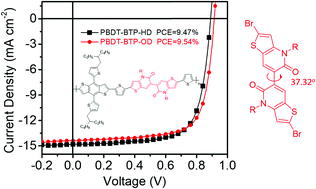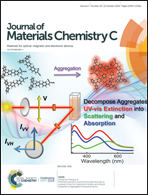A distorted lactam unit with intramolecular hydrogen bonds as the electron donor of polymer solar cells†
Abstract
A novel distorted lactam motif, namely 4,4′-dialkyl-[6,6′-bithieno[3,2-b]pyridine]-5,5′(4H,4′H)-dione (BTP), could lock itself by intramolecular hydrogen bonds. In view of the potential of the motif, two D–A conjugated polymers, PBDT-BTP-HD and PBDT-BTP-OD, with two different long side chains consisting of 4,8-bis(5-(2-ethylhexyl)thiophen-2-yl)benzo[1,2-b:4,5-b′]dithiophene (BDT) as a donor unit and BTP as an acceptor unit were designed and synthesized. Furthermore, the photophysical, electrochemical and photovoltaic properties of both polymers were investigated. The morphologies and molecular ordering of the neat polymers and blend films were also probed to relate the side chain structures with aggregation states and device parameters. The device based on PBDT-BTP-OD with IT-M exhibited a power conversion efficiency of up to 9.54% thanks to the synergistic effect of the building blocks and side-chain engineering. As a result, it is successfully demonstrated that the novel distorted lactam BTP is a promising building block in organic solar cells.



 Please wait while we load your content...
Please wait while we load your content...